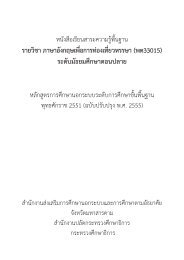bahasa indonesia
djenar-2003-a-students-guide-to-indonesian-grammar-oxford
djenar-2003-a-students-guide-to-indonesian-grammar-oxford
- No tags were found...
Create successful ePaper yourself
Turn your PDF publications into a flip-book with our unique Google optimized e-Paper software.
g'$J Mote<br />
Some intransitive verbs can take either the her- or the meN- refix<br />
A - -<br />
with no difference in meaning.<br />
bernyanyihnenyanyi<br />
berbekashnembekas<br />
to sing<br />
to leave a mark or trace<br />
Some other intransitive verbs take what are sometimes called<br />
pseudo-objects [nouns that look like objects, but are not perceived<br />
as being affected by the action]-see section 9.2.<br />
bermain @tar<br />
bertepuk tangan<br />
bersepatu coda<br />
to play the guitar<br />
to clap (one's) hands<br />
to roller-skate<br />
In these cases, we treat the verb and the following word as<br />
constituting one activity. In the previous examples, the words<br />
gitar, tangan and roda are considered as part of the verbs bermain,<br />
bertepuk and bersepatu respectively.<br />
A tmnsitive verb requires more than one noun or noun phrase for it to<br />
occur in a sentence. One of the nouns or noun phrases serves as the<br />
subject (as in intransitive verbs), while the other noun or noun phrase<br />
serves as object. Because the subject is typically the instigator of an action,<br />
we also refer to it as the actor. The object, on the other hand, is the person<br />
or thing that is affected by that action. We also refer to it as the patient.<br />
Kakak membaca surat.<br />
Older sibling reads the letter.<br />
I bu membawa keranjang.<br />
Mother carries the basket.<br />
Pak Harun membuka pintu.<br />
Mr Harun opens the door.<br />
54 A Student's Gu~de to Indonesian Grammar



